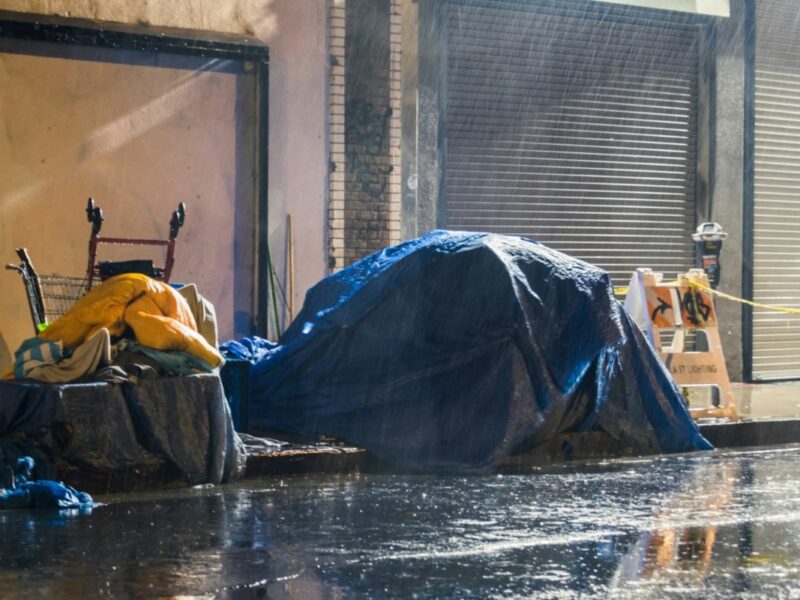State and government-sanctioned encampments are not what they’re being presented as to the public. These so-called “solutions” to homelessness bear a haunting resemblance to concentration camps. Here’s a bird’s eye view of things to come.
America has a harrowed history of locking up demographics of people. During World War II, approximately 120,000 Japanese Americans were forcefully placed in internment camps under the notorious Executive Order 9066. Of course, these internment camps were never advertised as such.
Although they operated similarly to concentration camps seen abroad, these facilities were branded under different names, a feigned attempt to soften the image altogether. Monikers like “war relocation centers,” “assembly centers,” and simply “camps” were used to describe the tar-papered shacks where Americans of Japanese descent were imprisoned for the duration of the war.
The move was met with very little public backlash and was done under the flimsy guise of “public safety.” Yet, in hindsight, historians are quick to denote them as the concentration camps of North America.
Similar actions have been taken against other marginalized communities in America’s not-so-distant past. Take, for example, the notorious “Native American boarding schools” where young children of Indigenous American heritage were held hostage, many killed. They, too, lived in dismal conditions, isolated, and subjected to some of the most heinous forms of abuse imaginable.
And, while the horrors of the Transatlantic slave trade are heavily documented, many Americans are unaware that post-Civil War America boasted internment camps for African Americans in the shadow of the aftermath of Black Wall Street.
All of this is to say that concentration camps have often existed in America, even if they were not specifically identified that way by name.
Perhaps even more tragic is the fact that these so-called camps still do exist and homeless people are the latest demographic to be thrown into them. These are the forced camps, the “sanctioned encampments” that crafty politicians are raving about in their latest campaigns.
While we toil away at our Snapchat and rotate the pictures on our timelines to show the world the highlights of our otherwise mundane lives, a new future is being built underneath our noses. This new future is sanctioned and adequately funded.
What if I told you that within your lifetime, the roads will be dotted with flammable boxes that look like sheds? Your children could live in a space the size of a prison cell with no bathrooms and faulty electrical wiring. This place is so similar to hell that, at any given moment, it might go up in flames.
It sounds outlandish, I know, but they’re already building it. And more than $10 million has been quietly funneled into the funding.
You may have heard of these pallet shelters. Perhaps you believe they’re a little sketchy, but you haven’t paid too much attention since they are, after all, for the homeless community.
What if I said they are actually for you because, like most Americans, you are already teetering dangerously on the edge of homelessness? What if it’s only a matter of time?
Middle-Income Earners Are Slowing Being Pushed Out of the Housing Market, and the Government Has the Perfect Place to Put Them
The national shortage of affordable homes stands at 7.3 million units strong. That number is only growing.
Rental rates have increased at a pace that quadruples the median wage growth. Home prices are at record highs, with the average house on the market now costing nearly half a million dollars. And according to findings from the Urban Institute, 80% of homes on the market are too expensive for middle-income and low-income earners to afford.
Housing advocates have long been demanding the government build more affordable homes. However, the lower the supply, the more profitable the real estate market becomes.
For this reason, homelessness is increasing at accelerated rates. The crisis is currently visible and causing quite a nuisance for self-absorbed NIMBYs, who constantly complain about how homeless encampments obstruct their expensive views of the city skylines.
The government has a “solution” in mind, but it certainly isn’t housing.
Enter the Sanctioned Homeless Encampment, Which Is Strikingly Similar to a Concentration Camp
Lately, there has been a political push for sanctioned encampments, which are government-run institutions – outdoor prisons, if you will.
What we know about these facilities so far is grim. They are supported by the notorious Cicero Institute, a despicable corporation that applauds the use of for-profit prisons and wants to bring a similar model outdoors.
Here are some of the features of sanctioned encampments that resemble the concentration camp model.
Similarity 1: Security Monitoring
A sanctioned encampment scheduled to open this summer will be heavily monitored by security across its 1,000-foot perimeter.
The city purports there will not be a police presence there. However, the site is slated to go up on the same day a ban on unsanctioned encampments will be enforced. It is difficult, borderline impossible, to enforce these laws without a police presence, so there’s that.
With or without the presence of law enforcement officials, the heavy security monitoring expected is very similar to the way concentration camps are patrolled.
Similarity 2: A Large Number of People from Minority Backgrounds in a Small, Cramped Space
Concentration camps are notorious for placing large groups of members from ethnic minorities into small, cramped spaces. Similarly, the homeless population in America overwhelmingly consists of people from ethnic minority backgrounds, many vastly overrepresented in the data.
With over 100 people being placed in each encampment, the space here would have to be crowded beyond belief. The pallet shelters and tents described in the blueprints for these facilities are precisely the same size as a prison cell. Are you getting the picture yet?
Similarity 3: Restriction of Freedoms
Encampment residents will be subject to small spaces and strict schedules, making it impossible for them to come and go as needed.
Not abiding by the sanctioned encampment schedule could mean being forced to sleep outdoors and sleeping outdoors when there’s a sanctioned encampment available means running the risk of imprisonment due to a quality-of-life violation.
This restricts encampments residents’ ability to work second and third-shift employment positions and engage in other activities after hours.
Similarity 4: Communal Bathrooms
The notorious Auschwitz concentration camp was finished with communal bathrooms on the ground floor. The wooden barracks where prisoners were held did not have a place for people to use the bathroom.
According to Auschwitz.com, “Each building had lavatories, usually on the ground floor, containing 22 toilets, urinals, and washbasins with trough-type drains and 42 spigots installed above them. The fact that prisoners from the upstairs and downstairs had to use a single lavatory meant that access was strictly limited.”
Similarly, prisoners (i.e., homeless people) are forced to share communal bathrooms and shower in a group setting in sanctioned encampment settings.
The Blueprint for the Future Has Been Drafted, but There’s Still Time to Urge Your Legislators to Draft Something Different – Laws that Make Housing a Human Right
Future generations should grow up in houses rather than heavily monitored campgrounds. People should be able to urinate in the privacy of their own homes rather than have to share showers with strangers. Our children should be able to enjoy the fundamental freedoms of eating, drinking, and working when they choose to do so.
Please contact your local legislators and urge them to make housing a human right for all. Not shelter, but housing. These eerie sanctioned encampments are what officials in our government perceive as shelter. This dehumanizing kind of existence is something they would subject anybody to if the price was right.













